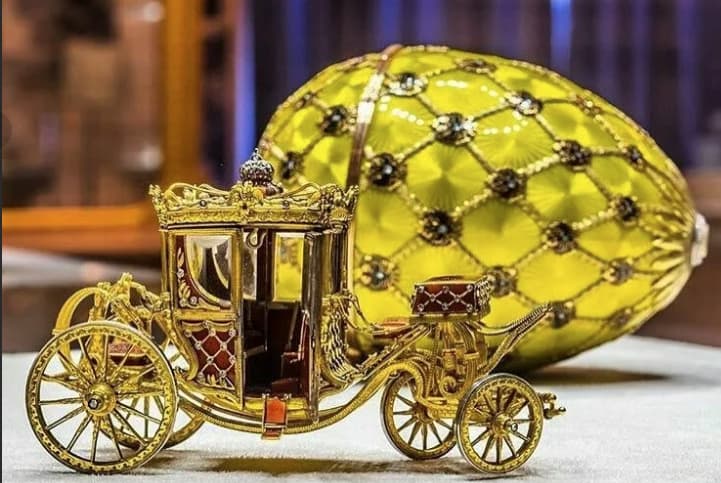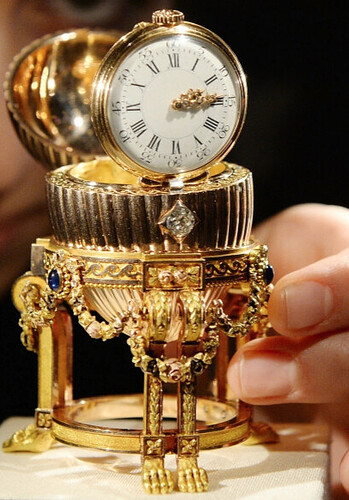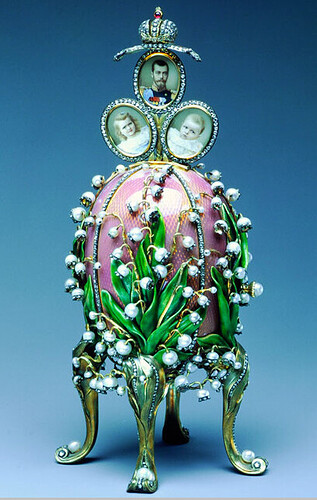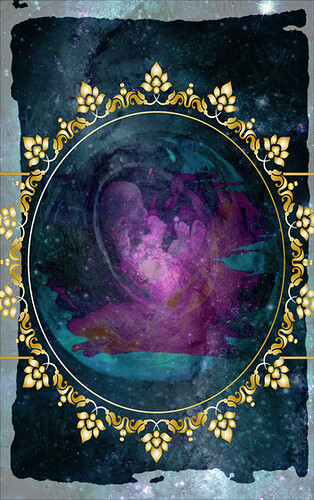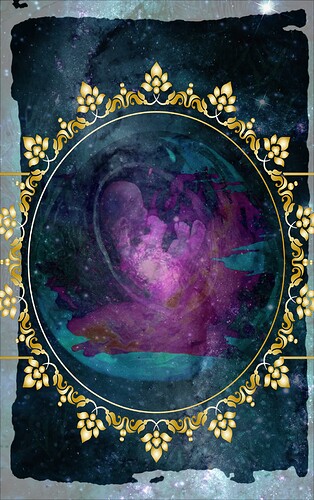Hello :)
There are a fair number of products on the market that cover the topic of money, wealth, and money mindset: Dragon of Wealth, our new friend Wealth General, also everyone has audio fields available: A life of Magical Abundance, Attract Wealth&Prosperity, Million Dollar Empire Mindset, Capital Governance, Abundance Mindset and many others. Also, please don’t forget that each of us has a unique opportunity to touch and ask for support and help from the strongest God of the Vedic pantheon, the lord of treasure, wealth, prosperity and well-being. He is that god of wealth, the generous giver of riches (colleagues, don’t forget our the 30 Day Kubera Challenge lol):
https://sapienmedicine.gumroad.com/l/MtBYK
The monetary and financial topic with such a huge arsenal of our Captain is “covered” completely (in our personal opinion). Recently, my colleagues and I were pondering on this topic, and we came to the conclusion that it is difficult to suggest something absolutely new to our Captain on this subject. Every Pantheon has its own deities who are responsible for finances/money, every magical tradition has its own methods of attracting money, prosperity…
We just tried to speculate…
Ask to create a “magic wand” or Aladdin’s Lamp? There is an absolute counterpart: Ignis Flos.
offer to recreate a certain money ritual? an energy money portal? a combination of precious and semi-precious stones to meet with money helpers? a royal crown with diamonds? an archetype related to financial well-being? a personal archetype of wealth? create a powerful symbol of abundance? a leprechaun chest? runic money stakes / processes? [there were still certain ideas, but perhaps they will be separately integrated into certain products in the future] […]
a powerful money artifact - an artifact of wealth, well-being and prosperity?
we have discarded all but the last idea lol
We decided that new concept / idea must include everything that can or cannot be imagined. We also understand that the money theme will arise in one way or another in different products (“Luck and Money” will be present in some NFT products as a minor addition), but in the “global” context for ourselves, we would like to close this theme completely. Also, this project has one important detail, the meaning “between the lines”. But about that a little later :)
I invite you all once again to immerse yourselves in Russian culture. To the very times when the Russian Empire reached its highest point of development and international influence. The times of the best ruler of the Romanov dynasty, at the very center of the Imperial family.
The history of the Romanov royal dynasty began in the 17th century at the Holy Trinity Ipatiev Monastery, when Michael Fyodorovich was solemnly called to the throne. The story of the Romanov Empire ended on the night of July 16 to 17, 1918, when the Bolsheviks executed the royal family.
The Romanov Empire is shrouded in mystery and riddles, with much mysticism and magic. For example, if Nicholay II had paid attention to the mystical symbols that surrounded the Romanov dynasty, perhaps he could have avoided a tragic death… But that’s another story altogether.
We invite you to the imperial jewelry workshop. The place where masterpieces of luxury and glamour were created for the imperial palace itself. These artifacts are the highest achievement of the famous Russian jewelry firm and are considered to be some of the last outstanding custom-made works of art. The Fabergé Jewelry House is still considered one of the most famous in the world.
If you don’t like long posts, if you don’t like historical narratives, don’t read lol
**The Fabergé Jewelry House**
Carl Fabergé was born in St. Petersburg in 1846 to a German and a Danish family. His father had his own jewelry workshop, and traditionally his son was to take over his father’s business. Carl was able to establish the largest jewellery firm in Russia, the activity of which determined the development of the jewellery industry in the late 19th and early 20th centuries (at that time St. Petersburg was considered one of the jewelry capitals of the world). But the idea of creating precious eggs did not originate with Carl himself, but with the Emperor of the Russian Empire, Alexander III. One day the work of the Fabergé jewelry house was seen at an exhibition by the emperor himself. He was stunned and decided to commission the jeweler to make an Easter present for his wife, Maria Fiodorovna. So in 1885 the first precious egg (“The Hen”) appeared.
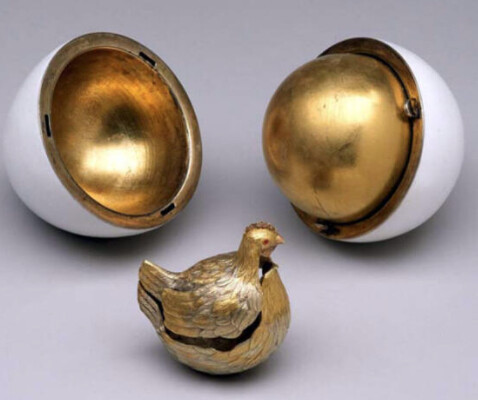
On May 1, 1885, the day of Holy Easter, Emperor Alexander III held out to his beloved Maria Feodorovna, a completely uninteresting, white enameled egg. It was about 7 cm long and looked like a large duck egg. When the Empress opened the Tsar’s gift, she was astonished: like a complicated matryoshka, it contained a yolk made of gold; inside the yolk was hidden a golden hen, sitting on a nest of golden straw; in the hen was hidden a miniature copy of the imperial crown with diamonds, inside which lay a tiny ruby pendant.
The mighty Emperor wanted very much to distract his wife from the threats of the terrorists, to distract her from her worries. As a loving husband he wanted to immerse her in memories of her happy childhood in Denmark, when Maria was still called Dagmar, and when everything was still cloudless and carefree…
The empress was delighted with such a gift. Fabergé was proclaimed court jeweler. He received an order from the emperor to produce an Easter egg every year. Carl was given complete freedom of action and creativity, but there was a strict rule: each egg must be unique and certainly with a surprise.
Since then, the imperial order for Fabergé Easter eggs became a regular occurrence - a tradition continued by the Emperor’s son, Nikolai II. Nikolai gave two eggs every Easter: to his widowed mother and to his wife Alexandra Feodorovna. The purchaser never knew what the egg would look like: it was left to the jewelers’ discretion. It took an average of a year to create one egg. It should be noted that Monsieur Fabergé did not create world-famous works of art with his own hands: he had a staff of eminent and very serious jewelers to work for him. He only drew sketches and supervised the work, considering himself a talentless jeweler.
All members of the Russian nobility at that time were acquainted with each other. Word of Fabergé’s skill spread at the speed of sound. Every rich family necessarily wanted jewelry by Faberge. Orders multiplied, and with it the business expanded - the company moved into a purpose built facility. Subsequently Fabergé opened offices in London and Kiev. In addition to manufacturing for the House of Romanov (which became the property of the royal family), Fabergé’s eggs found their way to Nobel, the American Duchess of Marlborough and the aristocrat Yusupov. Irkutsk merchant and gold industrialist Varvara Bazanova owned seven Fabergé eggs.
Over the following 32 years the jewellery house created at least 71 more eggs based on the matryoshka principle (with a surprise inside). Of those, 54 were for the royal family. Some 65 pieces have survived, 48-50 from the Imperial collection (this information varies from source). Most of the eggs were made of gold and jewels, but craftsmen also experimented with non-traditional materials, such as rock crystal and valuable types of wood. Proof of authenticity was always the stamp of the Fabergé firm.
None of the creations was the same, and the surprise that would be hidden in the new egg was kept in strict secrecy. Answering customers’ questions about what the new Easter gift would be, Fabergé would usually limit himself to a laconic phrase that sounded something like this: “You will be satisfied” (This is our Captain’s principle, by the way. Many of the bonuses he puts into his products are revealed over time)

In 1917, the October Revolution broke out, undoing all of the jeweler’s ambitious plans. The Bolsheviks, who came to power, declared all of Fabergé’s workshops and stores in Russia state property (some were taken out of the country). Many pieces were stolen, many sold for next to nothing. During the famine some of the jewels were resold many times (it is impossible to ascertain the location of many of them). Fabergé became a class enemy and hid from the Soviet authorities for nearly a year. Only in September 1918 he managed to leave his native city clandestinely, under the guise of a courier for a foreign embassy, and went to Finland. During the following two years the jeweler stayed in various cities until finally, at his old age, he settled in Switzerland with his family.
His son Yevgeny decided to revive his father’s business and opened the Fabergé Jewelry House in Paris. Incidentally, his most sworn enemy (competitor) for a century is the jewelry house of Cartier. In Russia, the master is highly respected and a museum was opened in 2013. A collection of 9 Imperial Easter Eggs, which managed to buy from different parts of the world, is presented.
Some interesting facts
How many eggs were created by the famous Fabergé workshop is still a mystery (and also opens up space for the imagination of swindlers). Many masterpieces from the Romanov Collection have been reconstructed from photographs of the time, while others are still under debate. Some say that the Romanov House collection consisted of 50 eggs, while others say it consisted of 54. Verifying the authenticity of the rest is not easy, since there are almost no documents of that time, and the seal was stamped only on the imperial eggs. But who knows where the four (eight, according to another version) lost eggs will be found?
- "The Winter Egg ($9.5 million).
The egg was commissioned by Emperor Nicholas II as a gift to his mother for Easter 1913. It is noteworthy that the author of the work and the new technique of “frosting on crystal” was the only female jeweler of the House of Fabergé - Alma Pihl.
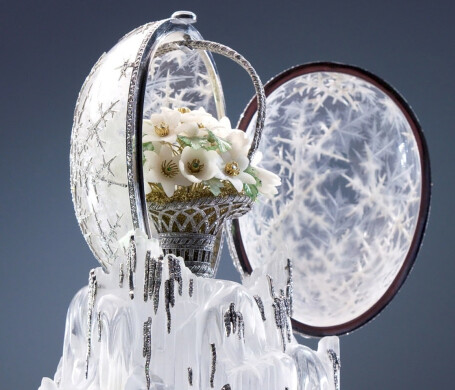
The jewel is made of rock crystal with the finest engraving resembling melting ice with streams of platinum and diamonds. At the top is a moonstone. When you opened the two transparent halves of the egg, you could find there a basket of the empress’s favorite flowers: snowdrops, decorated with emeralds and pink diamonds. Each flower was realistically carved from solid white quartz with gold wire as the stem and stamens, the leaves were delicately carved from jade, and their middles were from green quartz.
This egg was the most expensive of imperial eggs, for “Winter” egg to Faberge’s firm it has been paid 24 600 rubles. After revolution egg wandered from one private collection to another, until in 1975 has not disappeared.
Nineteen years later, the jewel was found in London and sold at a Christie’s auction to several other collectors, until in 2002 it ended up in the private collection of an emir of Qatar. The price of the lot was $9.5 million, and for a long time it was a record among the eggs of the collection.
- "The Rothschild egg ($18.5 million), the most expensive of the eggs, was not made for the emperor, but for the private collection of the Efrussi family.
No one guessed about the existence of this egg for a long time. The thing is that for more than a century it had been part of the private collection of American billionaires and was never advertised. However, in 2007, the crisis came, and the owners decided to put the treasure up for auction.

Egg-watch was created in 1902 by masters of the House of Faberge. Egg-watch is made of gold, decorated with diamonds, transparent pale pink and white enamel, platinum, is belted with a frieze, laid out of pearls. In the enameled transparent pale pink enamel Easter egg is built in clock of N. Rohde. The white dial is framed by a ring of pearls, painted with a closed, enveloping each digit in the form of garlands.
The opening top of jewelry egg is executed of pink gold, and under it a surprise is hidden: a mechanical, brightly enameled gold cockerel decorated with diamonds. On the back of the jewelry watch egg is an openwork circular door that reveals the intricate clockwork mechanism.
At the stroke of a new hour, the top hinges and a special mechanism lifts a mechanical cockerel from beneath its openwork lid that flaps its wings, opens its beak and sings. The movement is guaranteed by the winding mechanism: every hour the golden cockerel spreads its wings, flaps them four times, tilts its head three times, opens its beak and sings. The performance lasts 15 seconds, after which the bell strikes the hour. The appearance of such a unique specimen caused a real furor among collectors, and many wanted to get this pearl.
Russian billionaire managed to buy the egg for a record $18.5 million for the private museum of Faberge. Since 2007 it is on display in the Hermitage. Whether or not it is the original is an open question, considering that some of the pieces are replicas of recognized originals in other museums.
- Coronation Egg, 1897 ($24 mln )
This, perhaps Faberge’s most iconic egg, was presented by Emperor Nicholas II to his wife, Empress Alexandra Feodorovna, as a memento of her entry into Moscow on May 26th, day of their Coronation in the Uspensky Cathedral. Its outer shell is made of multi-coloured gold, embellished with translucent yellow guilloché enamel and black enamel double-headed eagles set with diamonds, a design recalling the heavy Cloth of Gold robe she wore at the ceremony. The jewelled monogram of the empress appears at the egg’s apex under a portrait diamond, with the date at the base. The egg opens to reveal a surprise in the form of a diamond-set enamelled gold miniature replica of the original 18th century carriage by Buckendahl which once contained an emerald drop, later replaced by a yellow briolette diamond (both lost). The 3 11/16 in. (9.4cm) coach took craftsman, Georg Stein 13 months to complete.
During the famine of 1921, an American businessman was able to purchase 11 Fabergé Eggs, but was unable to negotiate the purchase of the Coronation Egg. Instead, a London gallery bought the egg in 1927, where it remained until 1979. And then Malcolm Forbes (owner of the magazine) became the owner of the Coronation Egg until it returned to Russia in 2004. The approximate cost of the egg (the exact value was not disclosed) was $24 million. The buyer was (of course) a Russian billionaire.
- “The Third Imperial Egg” (about $33 million)
This egg was given by Alexander III to Empress Maria Feodorovna in 1887. Then it disappeared and was thought to have been lost forever. However, the egg was found more than 100 years later on the other side of the world in America. The owner of a pawnshop bought the golden egg at a flea market for $13,000 from a man who wanted to melt it down. But inside he found a woman’s watch of the famous Swiss brand Vacheron Constantin. Later he found out on the Internet that he bought a lost Faberge egg, decorated with sapphires and diamonds. The lucky man sold his find to a private collection.
In 2014, the trader became unspeakably rich when he sold the egg at a private auction for £20 million (about $33 million).
Unfortunately, there is no way to describe each egg. A lot of information can be found in the public domain. In the final part we would like to highlight a few more species that we really liked:
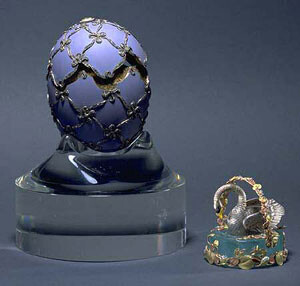
Яйцо Фаберже "Лебедь", 1906 год - YouTube
- Egg “Swan” was created in 1906 under the order of Nikolay II, who presented it to his mother Maria Fyodorovna as a traditional gift for Easter of 1906 in honor of the fortieth anniversary of wedding of Alexander III and Maria Fyodorovna.
Gold egg is covered with matte enamel of lilac color - the favorite color of empress Maria Fyodorovna, and it is decorated with an ornament in the form of a trellis grid of wavy ribbons decorated with diamonds of a cut “rose”. At the top is a large diamond, under which the year is indicated: “1906”. Other big diamond is fixed in the basis of egg.
Egg opens not evenly, but as though on a line of a chipping. In the middle of egg contains a surprise - a basket with a mechanical swan. The basket forms garlands of flowers from white, yellow and pink gold, edging an aquamarine support. On the base of a large aquamarine imitation of a lake, “floats” a miniature mechanical figure of a swan made of gold and coated in silver. Under one of the wings is hidden miniature winding mechanism - after winding, the swan spreads its wings, moves his legs and tail, raises and lowers the neck and head.
- The Peacock Egg was created in 1908 at the request of Nicholay II, who gave it to his mother Maria Feodorovna as a traditional Easter gift.
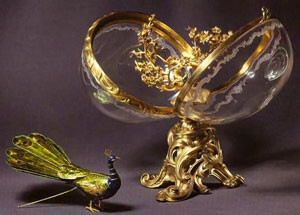
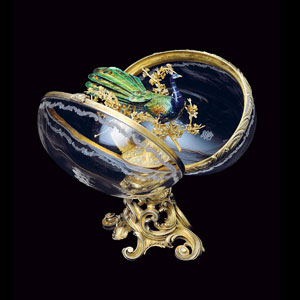
(Our Firebird, lol)
On a superb Rococo stand of gilded silver rests a transparent egg, both halves of which are carved from rock crystal and mounted in a frame with a clasp. Both halves have engraving on them: one depicts the imperial monogram of Maria Feodorovna, the other shows the date "1908. Inside the egg on the inlaid gold tree, among the branches covered with flowers from precious stones and enamel, sits a gold peacock painted with color enamel. The mechanical peacock can be removed from the branches. Once wound and placed on a flat surface, it begins to turn its head proudly and occasionally unfurl its tail.
- Lilies of the Valley Egg, 1898
This pink guilloché enamel Art Nouveau egg, presented by Emperor Nicholas II to Empress Alexandra Feodorovna, is virtually smothered with pearl- and diamond-set lilies of the valley sprays, her favourite flower, and is designed in her most-liked style. It stands on four cabriolet feet entwined with diamond-set foliage. The surprise, three miniatures of their eldest daughters, Olga and Tatiana, surmounted by a diamond- and ruby-set Imperial Crown, appears when one of the pearls is twisted.
- Nobel Ice Egg, 1914
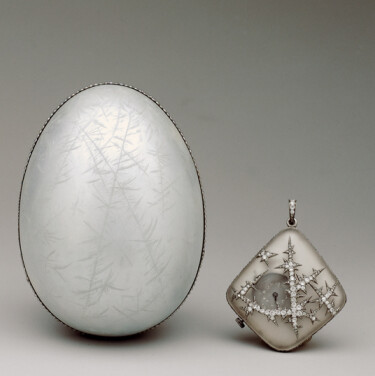
This platinum and translucent white enamel egg is engraved with underglaze frost crystals. Its surprise is a lozenge-shaped diamond-set platinum and rock crystal watch similarly decorated. This egg was commissioned by Dr. Emanuel Nobel, nephew of Alfred Nobel, of Nobel prize fame. Emanuel Nobel, one of the leading figures of the oil industry at the time, was amongst Fabergé’s most notable clients.
+ M O D E R N I T Y
As for the Fabergé brand, it has been sold to various companies over the years. However, today it belongs to the company Fabergé Limited and produces various jewelry items “based on” eggs. In 2015, after a long break, another Fabergé egg, the Pearl Egg, was released. It was created together with the influential Qatari Al-Fardan family, which is considered the largest collector of pearls in the world. Inside the mother-of-pearl case, adorned with 139 flawless pearls, is a unique gray pearl of 12.17 carats. The egg itself can rotate on the stand and reveal all 6 “petals” to reveal the surprise.
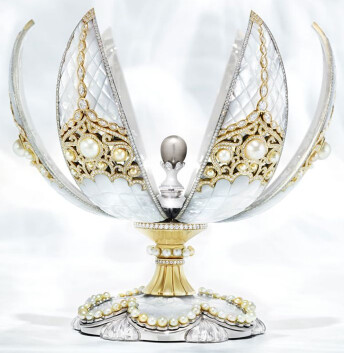
PS. A great deal of information can be found in the public domain, on the internet, on wikipedia and other resources.
Thank you for your attention
Absolute wealth & prosperity Int Group :)
This is the center, the artifact of the energy of wealth, prosperity, riches, power, glory, luxury. It contains the energy of true craftsmanship and true art. This is the energy of the wealth of the Imperial, royal house, and the brilliance and glamour of the jewelry houses of the world, the very source of abundance from all sources of abundance. Absolute flow which affects your whole reality, your thinking, your environment + full protection against financial failures, lack of money and everything that goes with it (No Deities/Gods or servitors lol)
btw, one fact is recorded in the historical concept:
All Fabergé Eggs were completely different. None of the master’s creations were the same. The surprise that would be hidden in a new egg was kept in the strictest secrecy. Answering the customers’ question about what a new Easter present would look like, Fabergé would usually limit himself to a terse phrase that sounded something like this: "You’ll be satisfied.
For each of us, the word “well-being / wealth” has an individual meaning that has to do with thinking, possessing whatever objects, privileges, and so on. We can sit down at the table, make a list of “what is wealth and well-being to me,” copy that list into a description. And any option you can conjure up will fit that NFT description (“how it should work”).
Does this story remind you of anyone? The principles of the Fabergé jewelry house, we are reminded of our Captain. Each of the Captain’s creations is a masterpiece. He treats each group - as a real Imperial House, each of us - as a little Emperor. He is a master of his craft, and he recreates our “orders” and wishes with jewel-like precision. He makes a perfect product out of an idea. And everybody is satisfied.
Quote: This beautiful project honoring Dreamweaver expands my heart to the bursting point […]
That’s the main idea and the final part of this long story.
Thank you, Captain :)
ps. Also, I sincerely thank the international group for their inspiration, their support of the main idea, their friendship, and their warmth :)


